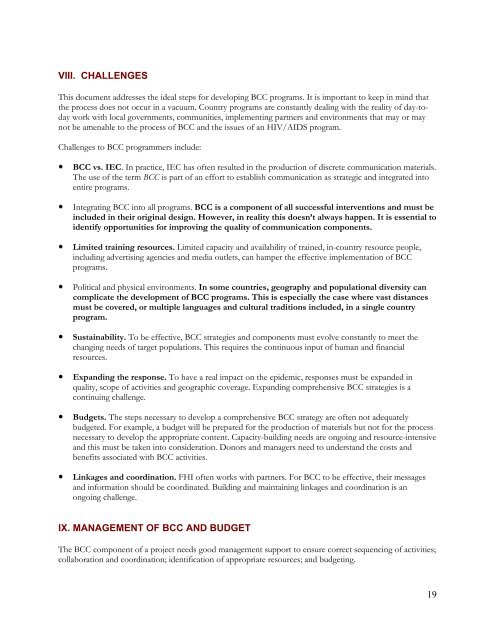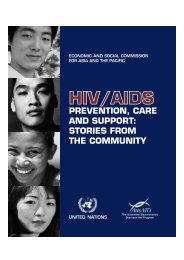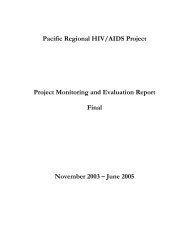Behavior Change Communication (BCC) for HIV/AIDS - hivpolicy.org
Behavior Change Communication (BCC) for HIV/AIDS - hivpolicy.org
Behavior Change Communication (BCC) for HIV/AIDS - hivpolicy.org
You also want an ePaper? Increase the reach of your titles
YUMPU automatically turns print PDFs into web optimized ePapers that Google loves.
VIII. CHALLENGES<br />
This document addresses the ideal steps <strong>for</strong> developing <strong>BCC</strong> programs. It is important to keep in mind that<br />
the process does not occur in a vacuum. Country programs are constantly dealing with the reality of day-today<br />
work with local governments, communities, implementing partners and environments that may or may<br />
not be amenable to the process of <strong>BCC</strong> and the issues of an <strong>HIV</strong>/<strong>AIDS</strong> program.<br />
Challenges to <strong>BCC</strong> programmers include:<br />
• <strong>BCC</strong> vs. IEC. In practice, IEC has often resulted in the production of discrete communication materials.<br />
The use of the term <strong>BCC</strong> is part of an ef<strong>for</strong>t to establish communication as strategic and integrated into<br />
entire programs.<br />
• Integrating <strong>BCC</strong> into all programs. <strong>BCC</strong> is a component of all successful interventions and must be<br />
included in their original design. However, in reality this doesn’t always happen. It is essential to<br />
identify opportunities <strong>for</strong> improving the quality of communication components.<br />
• Limited training resources. Limited capacity and availability of trained, in-country resource people,<br />
including advertising agencies and media outlets, can hamper the effective implementation of <strong>BCC</strong><br />
programs.<br />
• Political and physical environments. In some countries, geography and populational diversity can<br />
complicate the development of <strong>BCC</strong> programs. This is especially the case where vast distances<br />
must be covered, or multiple languages and cultural traditions included, in a single country<br />
program.<br />
• Sustainability. To be effective, <strong>BCC</strong> strategies and components must evolve constantly to meet the<br />
changing needs of target populations. This requires the continuous input of human and financial<br />
resources.<br />
• Expanding the response. To have a real impact on the epidemic, responses must be expanded in<br />
quality, scope of activities and geographic coverage. Expanding comprehensive <strong>BCC</strong> strategies is a<br />
continuing challenge.<br />
• Budgets. The steps necessary to develop a comprehensive <strong>BCC</strong> strategy are often not adequately<br />
budgeted. For example, a budget will be prepared <strong>for</strong> the production of materials but not <strong>for</strong> the process<br />
necessary to develop the appropriate content. Capacity-building needs are ongoing and resource-intensive<br />
and this must be taken into consideration. Donors and managers need to understand the costs and<br />
benefits associated with <strong>BCC</strong> activities.<br />
• Linkages and coordination. FHI often works with partners. For <strong>BCC</strong> to be effective, their messages<br />
and in<strong>for</strong>mation should be coordinated. Building and maintaining linkages and coordination is an<br />
ongoing challenge.<br />
IX. MANAGEMENT OF <strong>BCC</strong> AND BUDGET<br />
The <strong>BCC</strong> component of a project needs good management support to ensure correct sequencing of activities;<br />
collaboration and coordination; identification of appropriate resources; and budgeting.<br />
19











